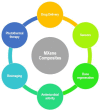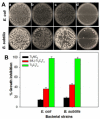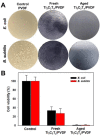MXene (Ti3C2Tx)-Embedded Nanocomposite Hydrogels for Biomedical Applications: A Review
- PMID: 35268907
- PMCID: PMC8911478
- DOI: 10.3390/ma15051666
MXene (Ti3C2Tx)-Embedded Nanocomposite Hydrogels for Biomedical Applications: A Review
Abstract
Polymeric nanocomposites have been outstanding functional materials and have garnered immense attention as sustainable materials to address multi-disciplinary problems. MXenes have emerged as a newer class of 2D materials that produce metallic conductivity upon interaction with hydrophilic species, and their delamination affords monolayer nanoplatelets of a thickness of about one nm and a side size in the micrometer range. Delaminated MXene has a high aspect ratio, making it an alluring nanofiller for multifunctional polymer nanocomposites. Herein, we have classified and discussed the structure, properties and application of major polysaccharide-based electroactive hydrogels (hyaluronic acid (HA), alginate sodium (SA), chitosan (CS) and cellulose) in biomedical applications, starting with the brief historical account of MXene's development followed by successive discussions on the synthesis methods, structures and properties of nanocomposites encompassing polysaccharides and MXenes, including their biomedical applications, cytotoxicity and biocompatibility aspects. Finally, the MXenes and their utility in the biomedical arena is deliberated with an eye on potential opportunities and challenges anticipated for them in the future, thus promoting their multifaceted applications.
Keywords: MXenes (Ti3C2Tx); biomedical; nanocomposites; nanomaterials; nanotechnology.
Conflict of interest statement
The authors declare no conflict of interest.
Figures













References
-
- Gupta A., Sakthivel T., Seal S. Recent development in 2D materials beyond graphene. Prog. Mater. Sci. 2015;73:44–126. doi: 10.1016/j.pmatsci.2015.02.002. - DOI
-
- Nguyen V.-H., Nguyen B.-S., Hu C., Nguyen C.C., Nguyen D.L.T., Nguyen Dinh M.T., Vo D.-V.N., Trinh Q.T., Shokouhimehr M., Hasani A., et al. Novel Architecture Titanium Carbide (Ti3C2Tx) MXene Cocatalysts toward Photocatalytic Hydrogen Production: A Mini-Review. Nanomaterials. 2020;10:602. doi: 10.3390/nano10040602. - DOI - PMC - PubMed
Publication types
LinkOut - more resources
Full Text Sources
Other Literature Sources

